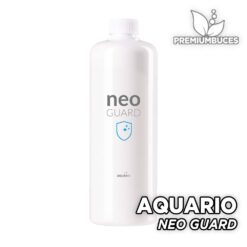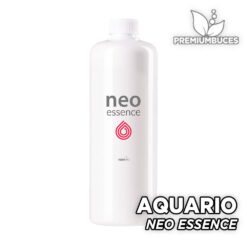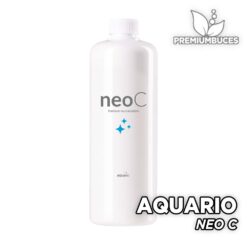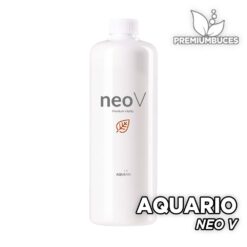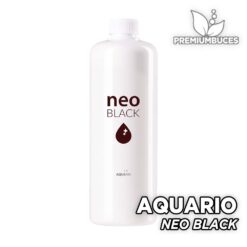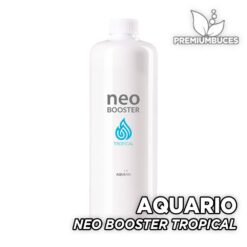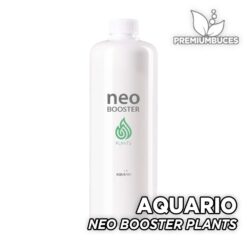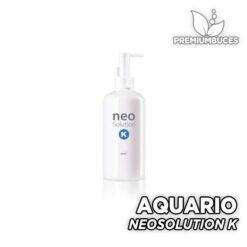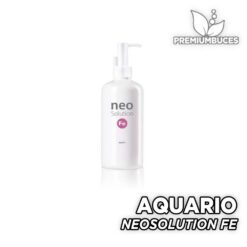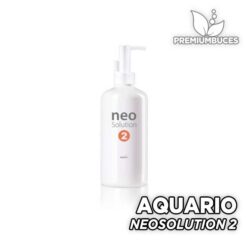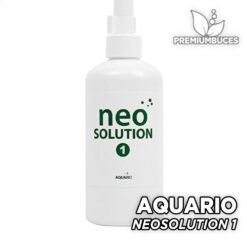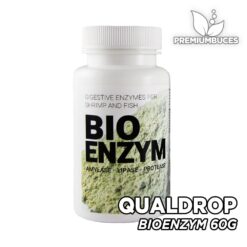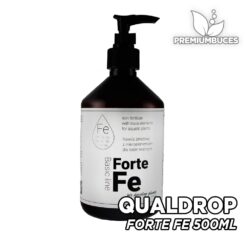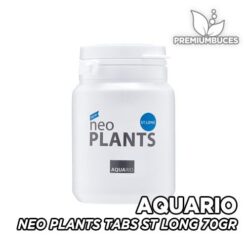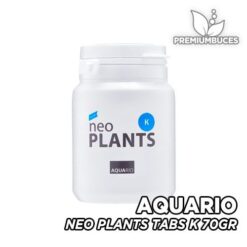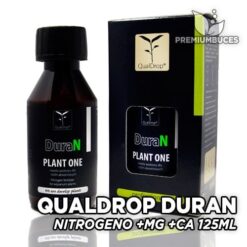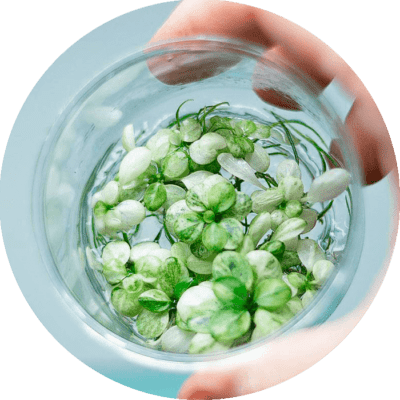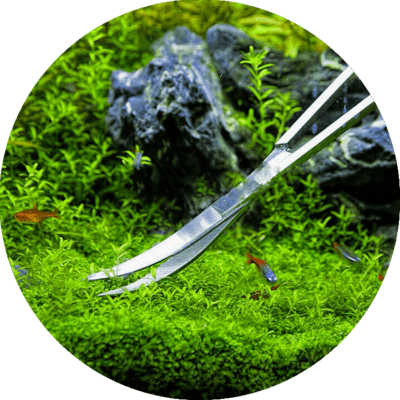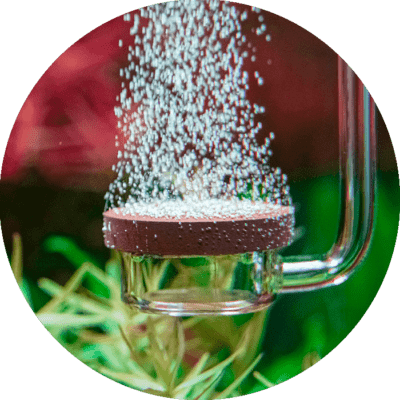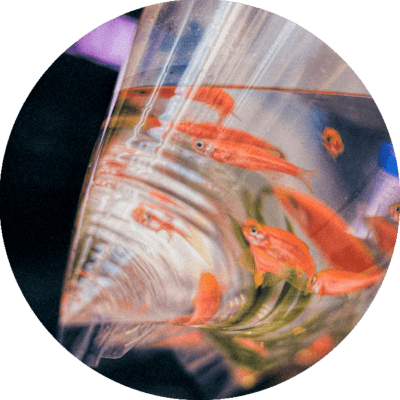Anyone who owns an aquarium, or is thinking of owning one, should know that constantly and meticulously changing the aquarium water is absolutely essential so that its inhabitants live well, are healthy and no more serious problems arise.
En Premium Divers We have talked to you about what are the water parameters that you must take into account to adapt to each type of fish and plant, we have talked about necessary processes to start well, like the aquarium cycling, and we have talked to you about what specific fish species need, such as Corydoras, but today we are going to talk about the most fundamental whatever type of aquarium you have: the water change, to be done regularly and constantly.
What steps must be followed to change the aquarium water? What do we do with the fish in the meantime? How can we get the chemical parameters that we had, are they still keeping with the water change? All these doubts, and many other questions, we are going to talk about in today's article. So if you want to know how to do this routine procedure to have a proper aquarium.
CHANGING THE WATER: WHAT HAPPENS IF WE DON'T PERFORM IT ROUTINALLY?
El aquarium water change It is something that you will end up dominating and doing almost without thinking, but at first you will have to pay enough attention to do it the right way.
First of all, as we have already told you in other articles, the water from our aquarium there must be generated a nitrogen circuit and other chemical parameters, as well as simply changing over and over again. The fish and living beings of the aquarium generate waste constantly, and these wastes produce substances harmful to your own life. If we were to rely exclusively on the water change, it would even have to be changed several times a day to make sure its inhabitants had the right circumstances.
So, before we even have fish, we will have to do the aquarium cycling: this process, which will take a few Two or three weeks more or less, it will ensure that in the aquarium they live in the biological filter some bacteria that will convert ammonia to nitrogen so that the fish are well. However, this is not enough, and if we only depended on these bacteria, the cycle would end up collapsing: fish waste would never be cleaned, And the bacteria would have too much work to be able to encompass it.
So the correct thing to do is join the process of exchange of ammonium for nitrogen at the hands of bacteria in the biological filter, along with a cleaning the aquarium water in periods of about ten days or two weeks. Thus, we will avoid knowing what would happen if we did not perform the water change routinely, since all these consequences would have as main victims fish and plants.
However, on the other hand, you have to be careful not changing the aquarium water too often. This is why we tell you that at first it will be difficult for you to adapt, although later you will get used to it and it will be easy peasy of doing:
Un constant water change, for example every few days, can end the bacteria that collaborate in the chemical balance of the water. If we have achieved that all parameters are perfect, and are ideal for the inhabitants of our aquarium, and then we change the water every two days, what we will do is make a chaos with these parameters: having to pay attention to the chlorine, ammonium, carbon dioxide and oxygen, and that's not to mention the temperature, which can also alter the health of the fish.
And then? ¿How do we do it? Well, you have to do the changing the water in a very specific way, and following a few simple steps that we are going to tell you next, and that if you follow to the letter, they will make everything go perfect and you will not have any problems.
POINTS TO TAKE INTO ACCOUNT BEFORE CHANGING THE AQUARIUM WATER
WHEN WILL WE MAKE THE FIRST WATER CHANGE?
Before starting to tell you one by one the steps to follow, let's talk about time as regards the aquarium mount. It is important that you know that when the aquarium for the first time, you will not have to do a cleaning until about 50 days after pouring in the first water in the aquarium.
Why so long? Well, because first the aquarium cycling process, which can last a few three weeks. To this is added that after cycling, you will have to put the fish in very little by little: if it is a community aquarium, you will have to put in one or two fish first, see how they get used to it and how they seem to be underwater, and then put them in a maximum of one pair during one more week.
That adds up a month in total, that is, 30 days. After this, when the aquarium is already assembled, with its aquarium cycling done and with all his inhabitants within (the fish, in the first place, but also the plants that must be under the aquarium water from the first moment in which the cycling is carried out), and we release, as it were, the aquarium for the first time normally, there will be what to expect 20 more days to change the water for the first time.
The fish have to start getting used to aquarium environment, with the nitrogen cycle done. Therefore, and although later, as we have said, it is advisable change the water every two weeks or so, in the first moment it will be good for them to be 20 days with the same first water to see how it goes with water parameters, check if they act strange, if they eat, if they seem sick, and thus have a real knowledge about how the water is, before changing it for the first time after cycling.
DO WE HAVE TO REMOVE ALL THE WATER FROM THE AQUARIUM?
This is one of the most common doubts when it comes to carrying out the aquarium water change. There are people who believe that completely change all the water every two weeks, which is a very cumbersome task, which takes a long time and also involves a lot of expense water.
But this is not so: when we change the water regularly, we have to change approximately one 20% of the total amount of water in the aquarium. For example if we have a large aquarium, 100 liters, we will only have to change some 20 liters more or less.
This percentage that we tell you is not to say, it is that removing just this part of the water will balance the two most important things that we look for when cleaning the aquarium: on the one hand, clean up dirt and excess debris against which he has not been able biological filterand on the other not end with the measurements of the water parameters that we have achieved during the first days of the aquarium.
However, and even if you have to do the 20% water change, as we have told you, once every ten days or two weeks, you will also have to do a total water change sometime. This depends a lot on the impression we have about how the aquarium is: if we see it excessively dirty, if we see that there is too much seaweed, or if we see that for some time fish and plants are not as they should and we have already tried to change only part of the water and it does not finish working. In all these occasions, it is best that we dedicate the necessary time to improve the aquarium totally, change all the water and do whatever it takes to balance parameters.
MATERIALS WE WILL NEED FOR THE WATER CHANGE
Once we have calculated that it's time to change the water of our aquarium, we will have to get previously with the suitable materials. All these things that we are telling you before talking about the steps of the water change, you will have to think hard enough time so that later once we have started to change the water, we don't have to improvise.
Well, for change the aquarium water routinely, we will need specific materials for it, and do not use under any concept no product that we have at home for other cleaning things. Maybe it seems logical, but any other cleaning productEven the most neutral soap, which is not specific for aquariums, can do a lot of damage to fish and plants that live in it, so get hold of this pack of instruments with which you can do each cleaning:
- Un aspirator or siphon, which we will use precisely to remove 20% of the water from our aquarium.
- Un cube, in which you will have to put the new water with which you are going to fill your aquarium by removing dirty water. Then we will tell you about it step by step, but this water you will have to leave it readyAt least the night before. If it can be, get hold of another cube more just in case.
- Una mop, because, obviously, water will fall when removing and putting on and you will surely have to scrub around the aquarium once you have finished with the whole process. In the same way we also advise you to prepare a towel and absorbent paper.
- Una sponge, to help you cleaning the aquarium glasses inside. The crystals get very dirty, due to the waste and also due to possible algae of your aquarium. This makes vision very difficult and is important, so that the aquarium looks clean After changing the water, make sure to clean the windows.
- Un water conditioner, like the one we have in the Premium Buces shop, which you will have to pour into the new water in the bucket before putting it in the aquarium. This conditioner will help us make new water optimal for the aquariumEg removing the chlorine and making it comply with the parameters more or less of the rest of the aquarium.
- Un biological complex, which is basically a compendium of nitrifying bacteria that will help us so that in that water change, the new water can adapt to the same nitrogen and low ammonium levels that we must have in the aquarium: that is, a product that helps us to to return to having the parameters that we obtain once the aquarium has been cycled. In this link you can see the biological complex that we have in our Premium Buces online store.
And that's it! The vast majority of these products will not have to be purchased for each aquarium water cleaning: both the siphon or aspiratorand cube and, of course, the materials to clean and dry the water, are things that we can all perfectly have in our house. With respect to water conditioner and biological complex of nitrifying bacteriaWe will simply have to buy it and it will last us for a few weeks to clean the water.
WHERE DO WE PLACE OUR FISHES WHILE CHANGING THE WATER?
Must move the fish around while we make all this 20% water change? Our answer is clear regarding this, although there is some debate and opinions of all kinds: U.S we do recommend moving the fish around while cleaning is in progress.
It is true that you have to have be very careful when changing places, and plan a place where you will be cleaning time where they can be as comfortable as possible, noting at least the change from one water to another. Now we will tell you little tricks to make this change in the least abrupt way possible. But the other possibility is that the fish stay in the aquarium while you You remove water, put a vacuum cleaner, clean the windows and then take out the decorative objects to clean them.
This translates into stress for fish, something that is really bad for them. It also translates into any of these movements you do them, without wanting to, hurt. Therefore we recommend that the best is change places in the meantimeYes, making sure that we make the change correctly and that the place we take them to is good for them.
Thus, the place where we take the fish must have, in the first place, the same temperature as the aquarium from which they come out. To do this, it is convenient to leave this container prepared with the water the night before: Thus will acclimatize the temperature of the water, and also will remove a bit of chlorine. It is important, if we let this water rest for part of the day, put the container in a neutral point where the sun does not shine, so that it does not get too hot, nor any current, so that it does not stay cold. In the event that you don't have enough time to let the Harmful chemicals in the water are removed naturally, you can always use a product called dechlorinator, and what can you find by clicking here.
Finally, talking about how to move the fish from the fish tank to the temporary place, another little tip: there are some people who use a net to quickly remove the fish and bring them to the container. If you are worried about stressing them out, or taking their breath away for a while, one thing you can do is use a medium bowl or container to make the change much better. You gently put your hand into the aquarium with the bowl in hand, sink it and leave it there until, having a lot of patience, the fish get closer to you. Then you can move the bowl to put the fish inside and take them in this way, within the aquatic environment, to the other temporary container.
However you make this change, so do we We recommend that you do not stop paying attention to the fish while they are in the temporary container waiting for the water change. If you are more than one better person, because then one of you will be able to see them and detect in the event that someone shows strange behavior, to be able to act on time.
Finally, you have to be also be very careful that the new container does not have traces of any type of soap or cleaner, which could ruin all the care of the water temperature so that the fish are well in that transit.
And now that we know the times we must wait to do the water change for the first time, as well as the amount of water that we must change exactly, materials that we are going to use to perform the entire operation and where and how should we leave our pets meanwhile, we are going to tell you the step by step of this process, so that you do not have any doubts when it comes to doing it routinely.
STEPS TO CHANGE THE WATER IN THE AQUARIUM
Only by following these steps, you will be able to make a completely successful water change. At first you will have to get the hang of it, but when you have done it a couple of times, it will be something you do almost without thinking. Go for it:
- First of all is prepare the new and clean water that is going to replace the one that was in the aquarium. 24 hours before, or the night before, we leave prepared normal temperature water in the bucket that we told you that you were going to need. During this time, the chlorine from the water will evaporate, but even so, as we have told you before, you can also cast conditioner to help remove chlorine completely.
- We also leave another bucket or container that we want with water prepared a few hours before to dislodge the fish. We miss him conditioner and we let the temperature cool down. These two steps will have to be carried out a few hours before to start changing the water.
- Once we have the two containers of water ready, we will take out the fish. We place them in the container that we have thought, in the way that we want but that is the least harmful for them. This will allow us the aquarium is empty and so we can manipulate it more easily.
- Now yes, we will proceed to dispose of dirty aquarium water. For this we will need the siphon or aspirator. We recommend the siphoner because this, by the way, clean the gravel of the aquarium, which never hurts. Of course, if you are going to clean the gravel in depth, take into account what is convenient for some types of fish, As the Corydoras what do you need searching through gravel as a form of natural behavior, and that perhaps they will appreciate that you do not leave the gravel without any type of waste. The water that we get dirty from the aquarium, that 20% we were talking about, will have to go to another cube. If you don't want to throw it away, you can use for other things like watering plants (something that will come in handy, because it is a water full of nutrients) or do the dishes. When you do this water change with the siphon or a vacuum cleaner, keep beware of plants so that they do not suffer: some plants have smaller roots They are easily unleashed from where they are planted, so be careful.
- Once we have removed the old water, and in the event that we have decorative elements in the aquariumas rocks, sticks and even boats or some other aesthetic objects, we must remove them with care not to damage the plants, because they will receive an extra cleaning. This is very important, because it can happen to us that we change the water again and again and still see that the parameters of the water are not balanced, or we have a level of toxicity in the water that we do not know where it comes from: these objects can accumulate waste and that we are not realizing. In the same way as with the other elements of the aquarium, these decorative objects they are not washed with soap and water. We recommend wash them very carefully under running water, trying with clean hands to remove any remains they may have.
- Still with him proportionally empty aquarium, we have to clean the windows of the same. This is also very important for the general appearance of the aquarium: if we change the water again and again but do not clean the windows, even if the water is clean we will always have a vision of dirt that will overwhelm us and will not allow us to see our aquarium in its entirety and the fish and plants that inhabit it. We use a sponge, without no extra cleaning product, simply with the aquarium or tap water support. Some people also use algae scrapers, which are specific to detach these pesky visitors from the aquarium panes. We have always been able to do it with the sponge, but this is because we do it constantly when we clean the water and don't allow the algae to get too sticky and dry on the glass.
- Once we have cleaned the windows, we can reintroduce the decorative elements into the aquarium. With great care we place them, already clean, waiting for the fish to accompany them. We know that we are very insistent on this issue, but it is no wonder: please, do not use any soap neither for the crystals nor for the decorative elements because this can be fatal for your fish, and all the care you have had up to this moment will be of absolutely no use.
- It's time fill the aquarium with clean water that we have prepared in a bucket. How should we introduce the water? Well, it is very, very important that you do it slowly. The water has weight, and if we drop the bucket carelessly, we will surely lift the gravel off the ground, as well as we will damage to plants and their roots. Cast the water very carefully, and with the help of another person in the event that the cube weighs a lot.
- When we already have the new water in the aquarium, we must, first of all, observe what does the water look like in general. Must make the water look crystal clear, and to the touch with the hand should have a temperature the same as it was when we had not yet added the new water.
- Now, with clean water and clean aquarium, we should pour the biological complex that we have bought. This, from our point of view, is indispensable, since it is inevitable that when discard a part of the dirty water that we have changed, we have lost nitrifying bacteria from the biological filter. So, to save us noticing that things are not going well in the days following the water change, we will give this hand to the biological filter and bacteria who are in charge of converting the ammonium to nitrite and nitrogen so that they can continue to maintain quality water. Pay attention to biological complex instructions that you use: there they will indicate the amount that you must add proportionally per liters of water, and it is important not to go over the quantity nor to fall short.
- We return to turn on the biological filter, which we will have turned off during this time, as well as the thermo-heater of the aquarium. Now everything is back to normal: our aquarium has the clean water, nourished with good bacteria for him, with clean decorative elements and glass and plants in place.
- We have left put our fish. In the same way that we have been careful when taking them to the temporary container, their return to the aquarium will have to take the same care. We take them in the container next to the aquarium and we take them out very quickly to introduce them in their place of origin.
- Spend some time to observe how the fish are in the new water. The positive part is that the fish immediately notice that something is not going well, so just spending a little time on this task, we will see if everything is going well in the water and the change suits them.
- Wait about 24 hours to see how the fish are in the new water to feed them. This way you will also give time to biological complex settling on the filter and be prepared for when the first fish food waste arrives.
AFTER THE WATER CHANGE: DO YOUR FISH PERFORM NORMALLY?
Let us make the case, unlikely but possible, that a few hours after we have made the water change, something goes wrong in it. We can notice it for different factors:
- That the water, even being just changed, appear cloudy just a little while later.
- The fact that fish have strange behavior: do not eat, move or interact, or in the worst case, lying on the bottom.
- That have come out of nowhere lots of algae.
What could have happened? Well, it could have happened that we had a mistake, and that Some of the steps to be carried out we have not done correctly. We may not have put in enough biological complex, or it may be, and this would be more harmful, than we have not completely removed the chlorine from the water.
We have already told you that chlorine is very harmful to the health of fish, and this will be noticed immediately. If we have not added enough biological complex and the filter is low in nitrifying bacteria, it is possible that what has happened in this time so that everything has fallen apart, is that the ammonium levels have risen.
So for fix this problem immediately what we have to do is use chemical compound tests that we must have at home, because regardless of the change of water, whenever our fish have a strange behavior, or something anomalous happens in the aquarium, they will have to be used.
En this link You can see in our online store some of the tests that you will always have to have available: the test to measure ammonia, fundamental for anything that happens in the aquarium, the test for measure nitrogen (in case the ammonium does not give us the information we needed), the measure chlorine and etc.
As soon as you use these tests, you will surely discover the reason for the chaos that has been created momentarily in the aquarium. Don't be overwhelmed, it's completely normal it has a solution And also this way you will learn for the next change, which will be in the next 10 days.
COMMON ERRORS WHEN CLEANING THE AQUARIUM
We have already learned what is the whole procedure to change the aquarium water correctly: we know how much time has to pass to make the first aquarium change, in which case we are beginners. We also know what materials are we going to need, and that on our website, Premium Divers, you can get almost all of them and of good quality. We have also learned how to make the change of scenery for the fish, something that we will have to master to never cause them any problem. And finally, we have learned the step by step of this cleaning routine that we will have to give to our aquarium.
In the last section we have talked about the worst situation that can occur to us when we have an aquarium at home, and that must be avoided at all costs: that we have not done a good step, and that this affects the quality of the water in our aquarium and therefore of the life of the fish.
But we are going to be more specific with this topic, and we are going to talk to you about some common mistakes that we think are not hurting the overall process, but they do and can spoil all other cares:
- We have already repeated it several times throughout the article, but The worst mistake that we could commit is not being aware that any of the instruments that we use, any of them, have a minimal residue of soap or cleaning chemical. This, however small, could lead to polluting the water and therefore make the fish sick even though in appearance everything looks clean and well.
- Another common mistake, which may seem insignificant but it is not, is that when we fill the bucket with clean water so that it rests until the moment of putting it in the aquarium, you have to let the tap water run for at least 30 seconds. Why? Well, because there are often in the taps pipes in our houses remains that are agglomerating, and that invisibly they can end up in the water that we will carry the fish. So that, we let the water run a little and when it is already clean of these remains, we throw it into the bucket.
- Regarding the water that we are going to pour, another common mistake es heat it artificially, instead of pouring it in and letting it sit long enough for its temperature to acclimatise. Few people know, but many artificial heaters carry copper, and this copper could end up in the water of our aquarium where our fish and plants live. You have to be very careful with that because it can cause problems and it will also be very difficult to detect it. Much better to let the water warm up naturally, with the time necessary to do so.
- Another common mistake es use a hose instead of a shower head or faucet to refill clean water in the aquarium change. The mistake is not simply using a hose, but misusing it: the hose has to let the water run for a while, as it may be that there is stagnant water for a long time in it, that this water has plasticizers that you have acquired from the inner hose lining, and that this causes, directly, a fatal poisoning or chemical poisoning of aquarium water, which would only lead us to have to change everything in the aquarium and start over from the beginning.
- The hose has another problem, which is the huge presión with which the water can come out. If we let that pressure come out with the water that we leave in the bucket, and then we do not let this water rest, it will take some pressure bubbles to our aquarium that if they resist they can be deadly to fish. How can it be? Because the pressure bubbles stick to their gills, causing them to suffocate. It may seem exaggerated, but it is something that is possible that happens and that it is better that you know so that it does not happen to you.
- Lastly, a common mistake, surely the most common of all errors when changing the aquarium water, is being in too much of a hurry for doing it. This is a task that even if you have mastered it, you cannot do it in ten minutes, and assume it It will prevent you from being in a rush to skip a step in the first place Essential because it is not giving you time to reflect each one and do it calmly. In second place, the rush will lead us to accelerate processes that can end in failure: not letting the water sit long enough y that has chlorine, don't do the shifting fish from one place to another delicately, do not give time for bacteria in the biological complex to adapt to the filter and to be able to do its function, throw in fish food too early and the water is filled with ammonia, and so on. Take it easy! Everything will be better, and we will lose much less time, if we take the necessary care to do everything at the first and that no problems arise.
We have reached the end of the article, where We hope you have learned what the procedure is to be able to do a partial water change routine that maintain the health of the aquarium and all its inhabitants always at the top. As with other processes that we have told you, only it will be more complex the first time. If we take care and affection in what we do, and above all, we think above all about the well-being of the living beings that are in our charge, everything will be fine.
For any other question you can keep visiting our blog.

